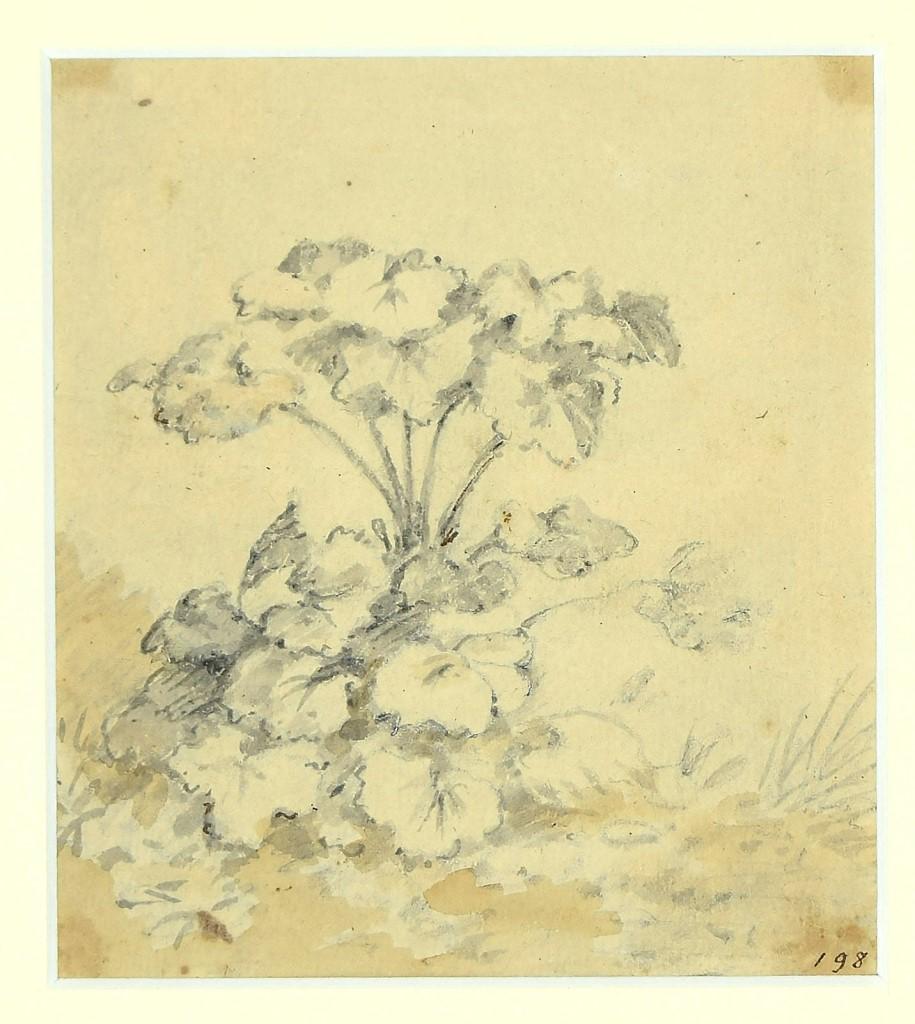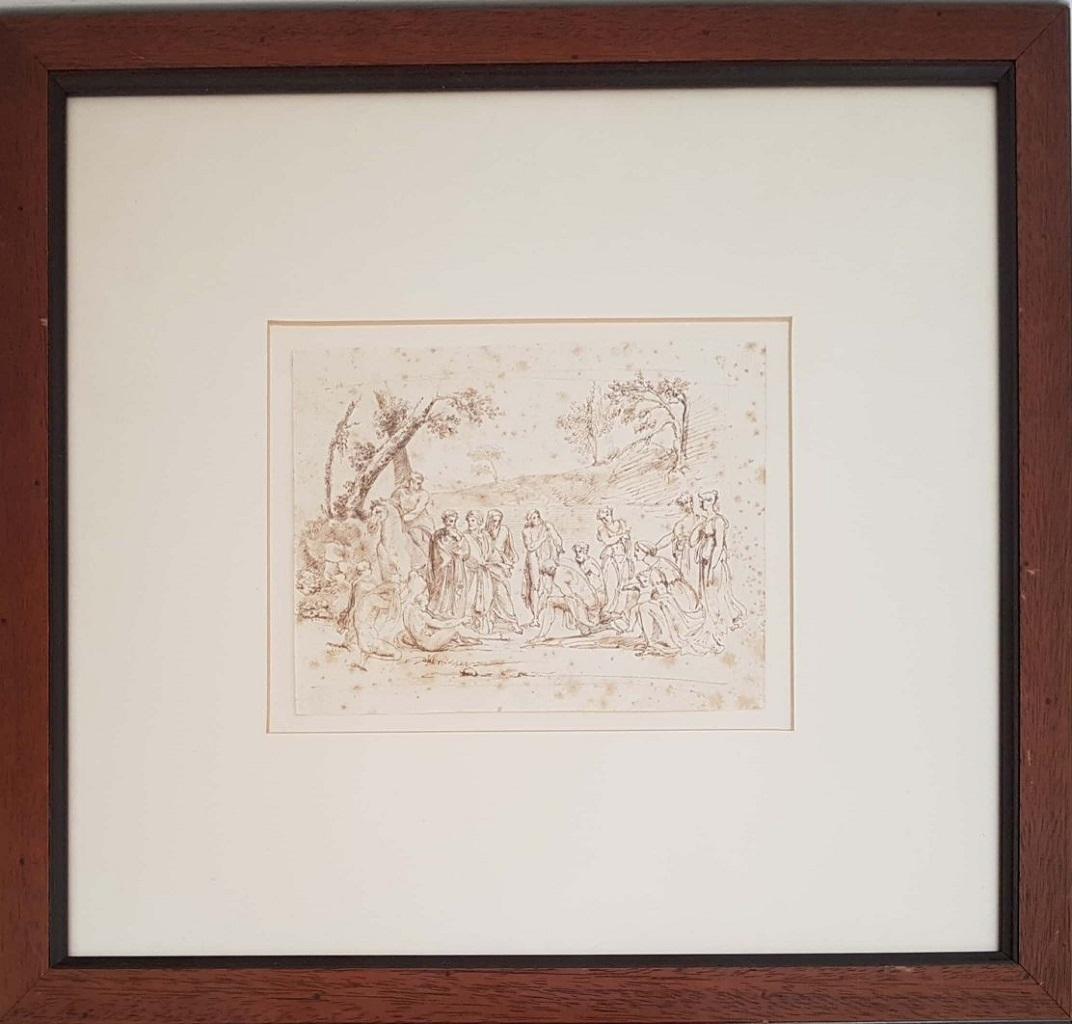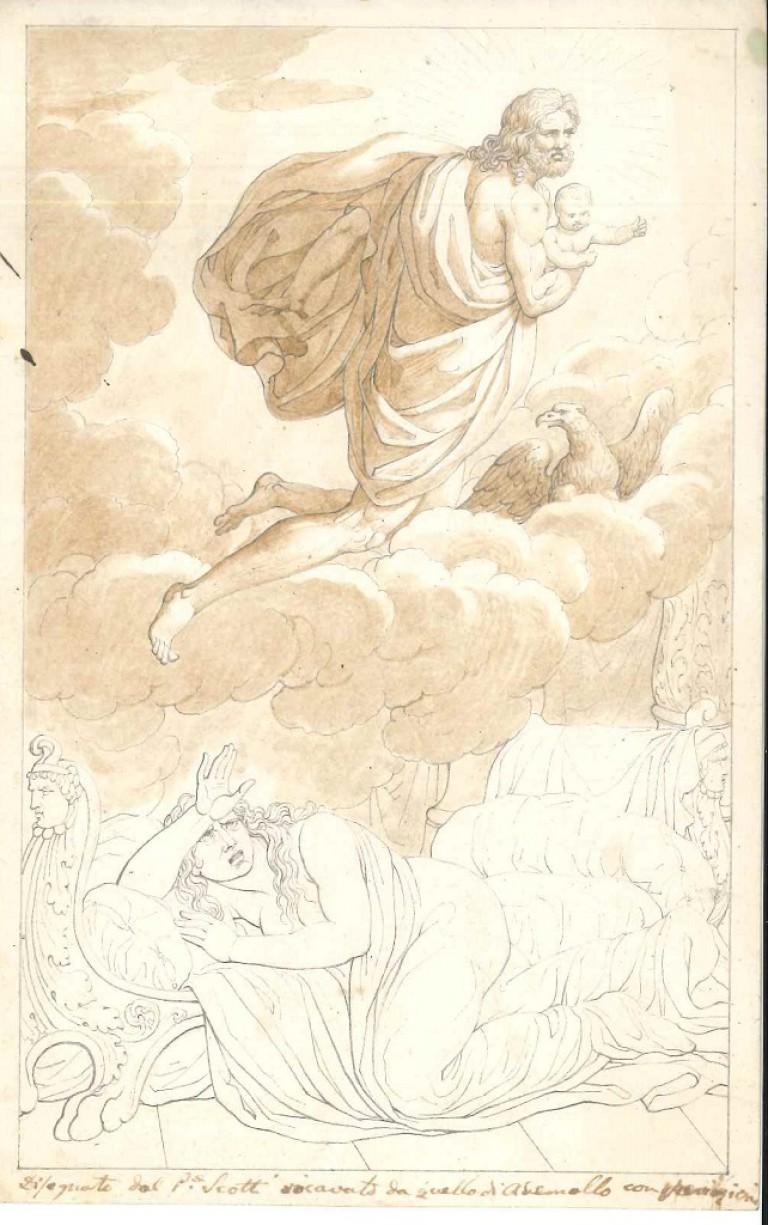Items Similar to Allegoric scene with the Tiber
Want more images or videos?
Request additional images or videos from the seller
1 of 2
UnknownAllegoric scene with the Tiber
About the Item
Allegoric scene with the Tiber river is a fine original drawing (black chalk on laid and watermarked paper at the center) by an exponent of the Neoclassical school of the nineteenth century.
In very good conditions, except for a mark of tape on the verso, visible on the recto, left margin.
The drawing shows a beautiful study of drapery, and the figures stand in a gentle pose.
This artwork is shipped from Italy. Under existing legislation, any artwork in Italy created over 70 years ago by an artist who has died requires a licence for export regardless of the work’s market price. The shipping may require additional handling days to require the licence according to the final destination of the artwork.
- Dimensions:Height: 9.45 in (24 cm)Width: 7.6 in (19.3 cm)
- Medium:
- Movement & Style:
- Period:
- Condition:Insurance may be requested by customers as additional service, contact us for more information.
- Gallery Location:Roma, IT
- Reference Number:
About the Seller
4.9
Platinum Seller
These expertly vetted sellers are 1stDibs' most experienced sellers and are rated highest by our customers.
1stDibs seller since 2017
6,830 sales on 1stDibs
Typical response time: 4 hours
- ShippingRetrieving quote...Ships From: Monaco, Monaco
- Return PolicyA return for this item may be initiated within 14 days of delivery.
More From This SellerView All
- Garden's Flowers - Ink and Watercolor Drawing by Jan Pieter Verdussen - 1750sBy Jan Pieter VerdussenLocated in Roma, ITGarden's Flowers is a beautiful artwork realized by Jan Peter Verdussen. In good condition. Not signed. Passepartout included ( 48.8 x 33.8 cm). The artwork represents a Garden's...Category
Mid-18th Century Old Masters Figurative Drawings and Watercolors
MaterialsPaper, Ink, Watercolor
- Female Nudes - Charcoal, Ink and Watercolor DrawingLocated in Roma, ITFemale Nudes is a fine original drawing (China ink and watercolor on paper). Unsigned. This artwork could be attributed to Thomas Stothard. Although th...Category
Mid-19th Century Old Masters Figurative Drawings and Watercolors
MaterialsCharcoal, Ink, Watercolor
- Madonna della ScodellaLocated in Roma, ITMadonna della Scodella is an original drawing (black pencil, pen and ink on laid paper) by an exponent of the Italian school of the eighteenth century. In excellent conditions: almo...Category
19th Century Old Masters Figurative Drawings and Watercolors
MaterialsInk
- Baptism of Christ - Ink Drawing by Anonymous XIX CenturyLocated in Roma, ITBaptism of Christ is a beautiful original drawing (pen and ink on paper) by an anonymous of the Neoclassical school of the beginning of the 19th century. A ...Category
19th Century Old Masters Figurative Drawings and Watercolors
MaterialsInk
- Mythological Subject - Charcoal and Ink DrawingLocated in Roma, ITMythological subject is a precious original drawing (black chalk, brush, and watercolor ink on ivory colored paper). Unsigned. Inscription: "Disegnato dal P. e Scotti ricavato da que...Category
19th Century Old Masters Figurative Drawings and Watercolors
MaterialsInk, Charcoal
- Woman - Original Ink Drawing and Watercolor by G. Dura - 19th CenturyBy Gaetano DuraLocated in Roma, ITWoman is an original watercolor artwork realized in the XIX century by Gaetano Dura. Good conditions except for yellowing of the paper, some folds on the higher and right margin, a...Category
19th Century Old Masters Figurative Drawings and Watercolors
MaterialsWatercolor, Ink
You May Also Like
- William Moritz (1816-1860) An historical scene, drawing signedLocated in Paris, FRWilliam Moritz (1816-1860) An historical scene, signed lower left Brown ink and brown ink wash on paper 17 x 16.5 cm Framed : 27 x 23.5 cm The subject of this charming drawing remains unclear but it's really easy to identify Queen Anne of Austria...Category
1850s Old Masters Interior Drawings and Watercolors
MaterialsInk
- Design for a large wooden confessional from the Santoni WorkshopLocated in Middletown, NYPen and grayish black ink on cream laid paper, 11 1/8 x 7 1/4 inches (283 x 185 mm), with the center of the sheet removed to create a window frame. Scattered light surface soiling, a...Category
Mid-20th Century Old Masters Interior Drawings and Watercolors
MaterialsInk, Laid Paper
- St. John the Baptist in the wilderness , Ecce Agnus Dei (Behold the Lamb of God)By Giovanni Francesco Barbieri (Il Guercino)Located in Middletown, NYPen and sepia ink and wash on vellum, 8 7/8 x 10 1/2 inches (225 x 267 mm). In very good condition with some modern notations in pencil on the verso, minor cockling, and a 1-inch hor...Category
Mid-17th Century Old Masters Portrait Drawings and Watercolors
MaterialsInk, Watercolor, Vellum, Pencil
- Modello for the Virgin of the Rosary, a drawing by Francesco Vanni (1563 - 1610)Located in PARIS, FRFrancesco Vanni is one of the last representatives of the long Sienese pictorial tradition. In this masterly composition in pen and ink wash, he presents the Virgin of the Rosary, holding the Child Jesus on her lap, surrounded on her right by Saint Dominic and on her left by Saint Catherine of Siena. The presence of these two emblematic saints of the Dominican order is a reminder of the devotion of this order to the Rosary. 1. Francesco Vanni, a Sienese painter of the Counter-Reformation Francesco Vanni was the most important Sienese painter of the late sixteenth century and a key Italian Counter-Reformation painter. He developed a very specific style, inspired not by Florentine models but rather by the Roman, Bolognese and Marche schools, and in particular by the work of his contemporary Federico Barocci (Urbino 1535 - 1612), despite the two artists never meeting. Francesco Vanni was born in Siena around 1563-1564. His father died in 1567 and his mother remarried Arcangelo Salimbeni (1536 - 1579), then one of Siena’s leading painters. His half-brother Ventura Salembini (1568 - 1613) also became a well-known painter. He continued his apprenticeship in Bologna and Rome, where he joined the painter Giovanni de Vecchi’s (1536 - 1614) studio, where he was greatly influenced, like other Tuscan painters of the time, by the art of Federico Barocci. He devoted himself mainly to religious painting, following the canons of the Counter-Reformation. Travelling between Siena, Rome, Bologna and Parma, in 1604, he settled in Siena, where he ended his life. Vanni was also an important member of the Confraternity of the Sacro Chiodo, renowned for its demanding religious practices. His legacy also includes some important engraved work. 2. Description of the artwork The Virgin is depicted enthroned in majesty, slightly taller than the other figures that she dominates from her pedestal. Her wide robe with marked folds evokes Renaissance statuary. She is crowned by two angels in the sky. These two angels are a reminder of the custom of adding angels to crown 13th century icons which was frequent at Vanni’s time. The Child Jesus is standing on the Virgin’s right knee. With her left hand she holds out a rosary to Catherine of Siena, identifiable by a branch of lily in her hand. In a symmetrical gesture, the Child Jesus also holds out a rosary to St Dominic. Two of St Dominic’s attributes are to be found at the foot of the Virgin: a book and a branch of lilies. Vanni gives particularly delicate treatment to St. Dominic's long and slender hands. The two outstretched rosaries form the link between the heavenly register of the Virgin and the Child Jesus and the earthly register of the two Dominicans who are not crowned with a halo. This and the fact they are followed by a large crowd, indicates that they are both represented as part of the multitude of the living called to pray to the Rosary. According to the classical iconographic tradition, it would be plausible to consider that the figure looking at the viewer on the extreme left of the drawing could be a self-portrait of the painter. Francesco Vanni's face is known to us from a self-portrait kept in the Pinacoteca Nazionale in Siena. The squaring of the drawing suggests that it was used for a larger-scale altarpiece, probably for a church dedicated to St Dominic or for a Dominican convent. As of today, we have not identified the painting for which this drawing served as a preparatory modello. The Madonna of the Rosary in the Cathedral of Pitigliano (painted by Francesco Vanni in 1609) differs quite significantly from our drawing by the addition of Pope Pius V, and the inclusion of St. Dominic and St. Catherine in the celestial register. We believe that our drawing predates this painting because of its more symmetrical composition, and less Baroque influence. The presence of Saint Catherine of Siena, particularly venerated in his native town, to which Francesco Vanni returned frequently from 1590 onwards, leads us to propose a date of around 1590 - 1600 for this drawing. 3. The Rosary and the Dominican Order In order to clarify the iconographic meaning of this artwork, it is worth recalling the role of Saint Dominic in the spread of the Rosary prayer. Dominic Nuñez de Guzman was born around 1170 in Caleruega (near Burgos) in Spain and died in 1221 in Bologna, Italy. He was the founder of the order of friar preachers, commonly known as the Dominicans. He was canonised by the Church in 1234 and has since been celebrated under the name of Saint Dominic. After three days of prayer in the forest of Bouconne, near Toulouse, Dominic is said to have received the Rosary as a means of converting the Cathar population. The Dominicans subsequently made a special effort to promote this form of meditative prayer. Pope Pius V, a Dominican, included the feast of the Rosary (on October 7th) in the liturgical calendar in 1571. Rosary prayer has evolved over the centuries and traditionally consists of the recitation of three rosaries (four since St John Paul II). Each rosary consists of five tens of "Hail Mary...Category
16th Century Old Masters Figurative Drawings and Watercolors
MaterialsPen, Ink
- Louis Lesueur (1746-1803) Landscape with ruins, 1789, drawing signed and datedLocated in Paris, FRLouis Lesueur (1746-1803) A Fantasy Landscape with ancient ruins, 1789, signed and dated "L Lesueur 1789" in the bottom centre Pen and ink and ink wash on paper 14.8 x 22 cm In goo...Category
1780s Old Masters Landscape Drawings and Watercolors
MaterialsInk
- Louis-Félix de La Rue (1730-1777) A Mythological scene, drawingBy Louis-Félix DelarueLocated in Paris, FRLouis-Félix de La Rue (1730-1777) A Mythological scene Pen and black ink on paper Bears an old inscription with the name of the artist on the lower left bo...Category
1770s Old Masters Figurative Drawings and Watercolors
MaterialsInk
Recently Viewed
View AllMore Ways To Browse
Old Master Italian Drawings
Nineteenth Century Drawings
Old Master Ship
Allegorical Figures
Vintage Ink Stands
Neoclassical Ink Drawing
Italian Old Master Ink
Chalk Figures
Figurative Neoclassical Paintings
Drapery Neoclassical
Wilson Jim
Eric Morgan
Harvard Charm
Harvard Charms
Lauren C Artwork
M Palacios
My Sin Lanvin
Red Chalk 17th Century Drawings





